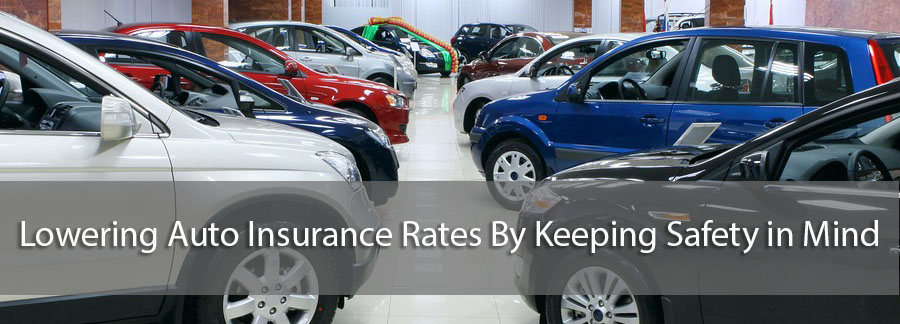“Be safe!”
When you were younger, your mother or father probably said something like that to you whenever you were heading out onto the road. Back then, they probably had good reason to, given that motor vehicle accidents have long been the top cause of death among teenagers and young adults. But this advice holds true for any age driver for another reason: better auto insurance rates.
You see, the amount of money you pay for auto insurance is almost completely determined by statistics. Some of those metrics you cannot control – for instance, younger drivers tend to pay more for auto coverage than older ones because more collisions (and their resulting injuries) are caused by people under 30 than by other working-aged Americans.
Make “Driving Safety” Your Co-Pilot
In contrast, you are responsible for your own driving record, including how many citations you receive and the number of accidents you are involved in – both of which are indicators of unsafe driving. Because riskier drivers are more likely to require insurance claim payments (either for themselves or others), auto insurers will charge them higher premiums. But the reverse is also true: safer drivers represent a smaller risk to insurance providers, so these individuals will pay less for auto coverage.

So how can you become (or remain) a “safe” driver?
A major part of the answer is to heed all of those warnings you heard from your driving instructors. This means engaging in behaviors like checking your mirrors consistently, observing speed limits, maintaining safe following distances on highways, obeying traffic laws, and exercising caution in adverse driving conditions. But it’s also important to refrain from dangerous activities like operating a mechanically unsound vehicle or driving while texting, distracted, drowsy, or under the influence of alcohol or drugs.
Choose a Safe Vehicle
Being a safe driver in the eyes of insurers actually begins when you purchase, lease, or otherwise acquire your vehicle. That’s because vehicles differ on how “safe” they are based on auto accident rates. As a result, auto insurance providers will charge lower premiums to owners of vehicles which are statistically less likely to be involved in an accident than those that are more frequently involved in collisions.
So what precisely makes a vehicle “safe?” Well, various organizations conduct crash tests and other research to see how today’s vehicles fare, and insurers tend to charge less for coverage on those vehicles which perform well in these tests. You can see how well your vehicle measures up at the Insurance Institute for Highway Safety website.
Auto Safety Features: The More, The Merrier
In addition, insurance companies reward drivers with lower rates for vehicles which come with additional safety features. For instance, all cars, trucks, SUVs, and vans manufactured after 1998 are required to have driver’s side air bags, which reduce the risk of major injury to a driver who is involved in a crash. Most carriers use ‘symbol rating’, which wraps all of the safety features and accident experience for a vehicle into a single number for rating purposes, rather than offer individual discounts for each item.
There are many other common vehicle safety features that frequently result in a lower premium, including:
• Passenger-side airbags
• Anti-lock brakes
• Rear-view cameras
• Tire-pressure monitoring systems
Also, there are other more advanced safety features that are available as optional equipment on many of today’s new cars, trucks, and SUVs.
• Electronic stability control. Required on all passenger vehicles since 2012, these technologically-advanced systems utilize computer sensors to minimize the risk of skidding or rolling over when the driver is forced to engage in sudden or sharp steering maneuvers.
• Daytime running lights. When a vehicle’s headlights automatically illuminate upon engine startup, they can help prevent daytime or low-light collisions by making the vehicle more visible to nearby traffic.
• Automatic seat belts. Though these are rarely found in vehicles made after 1998, motorized seat belts that fasten when the car door is closed are often viewed in the same light as air bags when it comes to collision injury prevention.
• Emergency response systems. These systems can vary, but they can automatically perform certain functions in the event of a collision, such as unlocking vehicle doors to facilitate the occupants’ exit, cutting off the flow of fuel to prevent vehicle fires from igniting or growing, and notifying first responders to more quickly provide medical assistance to those who are injured.
Though the aforementioned features have been in existence long enough for their advantageous effects to show up in national collision data, there are others that are so new that they do not appear in crash statistics. This means that while they may very well help provide a safer driving experience, these technologies might not affect your premium (yet). Some examples of these features include:
• Collision-avoidance systems
• Lane-departure warning systems
• Automatic emergency braking
• Electronic braking assistance
• Traction control
• Adaptive cruise control
• Adaptive headlights
• Night vision
• Obstacle detection
• Blind spot detection
• Pedestrian detection
• Back-up warning
• Curve speed warning
• Forward collision warning
• Road surface warning
• Drowsiness alert
• High speed alert
• Rear cross traffic alert
• Hill ascent and descent assist
• Lane keeping assist
• Parking sensors
• Side view cameras

Keep Those Auto Thieves at Bay
Although collisions and their resulting injuries represent the largest category of auto insurance payouts, another significant type of claim is auto theft. Therefore, any measures that you are willing to take to prevent your vehicle from being stolen are likely to be rewarded by your auto insurance provider in the form of lower premiums. The most common types of anti-theft devices for vehicles are car alarms, steering wheel locks, engine kill switches, VIN-etched parts or equipment, and vehicle recovery systems (like LoJack).
Go Back to School
Finally, one of the least-known ways to lower your car insurance payments by demonstrating your commitment to safety is by completing a driver safety course. Commonly known as “defensive driving” or “driving school,” these courses are offered either in traditional classroom format or via the Internet. Even if you are required to enroll in such a course to address a traffic citation or moving violation, you can still notify your insurer upon course completion and receive a discount of around ten percent on your premiums. However, the rules vary by state. California, for example, only allows a discount for these courses if you are a senior.
AIS Can Help
If you already have an anti-theft device (or have completed a driver safety course), make sure that your insurance provider knows about it. If you need help finding affordable auto insurance coverage for your vehicle, contact a specialist at AIS today for a free auto insurance quote.
The information in this article was obtained from various sources. This content is offered for educational purposes only and does not represent contractual agreements, nor is it intended to replace manuals or instructions provided by the manufacturer or the advice of a qualified professional. The definitions, terms and coverage in a given policy may be different than those suggested here and such policy will be governed by the language contained therein. No warranty or appropriateness for a specific purpose is expressed or implied.



